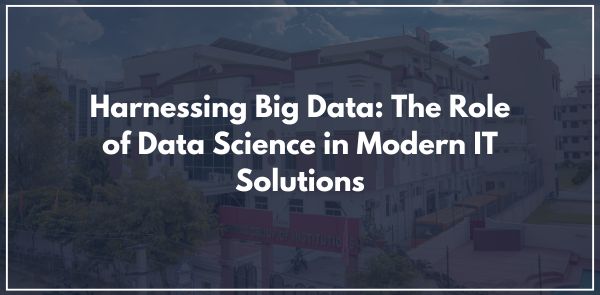
In the digital age, data has emerged as a critical asset, often compared to oil in its transformative power. The explosion of data generated from various sources—social media, IoT devices, transactions, and more—has led to the rise of big data. However, raw data alone is not valuable; it requires proper analysis and interpretation to extract actionable insights. This is where data science comes into play, serving as the backbone of modern IT solutions and driving innovation across industries.
The enriched learning environment at Poddar International College is one that centres on several hands-on projects that enable students to analyse and interpret complex data, preparing them to address real-world challenges. While the college focuses on connecting theoretical with practical exposure, it cultivates professionals ready for the future who can apply Big Data for strategic decisions in IT and beyond.
What is Big Data?
Big data refers to vast volumes of data characterized by the three Vs: Volume, Velocity, and Variety. These massive datasets can be structured, semi-structured, or unstructured, and they require advanced methods and technologies to store, process, and analyse effectively. The ability to harness big data allows organizations to uncover patterns, correlations, and trends that were previously hidden.
While big data holds immense potential, it also presents significant challenges:
Data science combines statistical analysis, machine learning, data mining, and data visualization to extract meaningful insights from big data. It involves several key components:
1. Data Collection and Preprocessing
Data scientists gather data from multiple sources, which is often messy and incomplete. Preprocessing involves cleaning the data, handling missing values, and transforming it into a suitable format for analysis. This step is critical as the quality of data directly impacts the accuracy of insights derived.
2. Exploratory Data Analysis (EDA)
EDA involves summarizing the main characteristics of the data, often using visual methods. It helps in understanding the underlying patterns, spotting anomalies, and formulating hypotheses. Tools like Python's Pandas and visualization libraries like Matplotlib and Seaborn are commonly used.
3. Model Building and Machine Learning
Data science leverages machine learning algorithms to build predictive models. These models can identify trends, make forecasts, and automate decision-making processes. Techniques range from simple linear regression to complex neural networks and deep learning. Choosing the right model and fine-tuning it for optimal performance is a critical skill for data scientists.
4. Data Visualization
Visual representation of data makes it easier to understand complex patterns and insights. Effective data visualization tools, such as Tableau, Power BI, and D3.js, enable stakeholders to grasp findings quickly and make informed decisions.
5. Deployment and Monitoring
After developing a model, deploying it into production environments is crucial for real-time data analysis. Monitoring the model’s performance ensures it continues to provide accurate insights and allows for adjustments as new data becomes available.
1. Enhanced Decision Making
Data science enables organizations to make data-driven decisions. By analyzing historical data and identifying trends, businesses can forecast future scenarios and make strategic choices. For example, retailers use data science to optimize inventory management and personalize marketing campaigns.
2. Improved Customer Experiences
Understanding customer behaviour is essential for delivering personalized experiences. Data science helps in segmenting customers, predicting their needs, and tailoring services accordingly. E-commerce giants like Amazon leverage data science to provide product recommendations, enhancing customer satisfaction and loyalty.
3. Operational Efficiency
Data science can streamline operations by identifying inefficiencies and optimizing processes. In manufacturing, predictive maintenance models analyse sensor data to forecast equipment failures, reducing downtime and maintenance costs. Similarly, logistics companies use route optimization algorithms to improve delivery times and reduce fuel consumption.
4. Fraud Detection and Security
Financial institutions employ data science to detect fraudulent activities by analysing transaction patterns and identifying anomalies. Machine learning models can flag suspicious behaviour in real-time, preventing fraud and enhancing security measures.
5. Healthcare Advancements
In healthcare, data science is revolutionizing patient care and medical research. Predictive analytics models assist in diagnosing diseases early, personalizing treatment plans, and managing patient records efficiently. Additionally, analysing genomic data helps in understanding genetic disorders and developing targeted therapies.
6. Smart Cities and IoT
The integration of data science with IoT technology facilitates the development of smart cities. By analysing data from sensors and connected devices, cities can optimize traffic flow, manage energy consumption, and improve public services. This leads to sustainable urban living and enhanced quality of life for residents.
As technology advances, the role of data science in harnessing big data will continue to expand. Emerging fields like artificial intelligence, quantum computing, and edge computing will further enhance data processing capabilities. Moreover, ethical considerations and data governance will become increasingly important, ensuring that data is used responsibly and transparently.
Data science plays a pivotal role in unlocking the potential of big data, transforming it into valuable insights that drive modern IT solutions. By mastering the art and science of data analysis, organizations can enhance decision-making, improve customer experiences, boost operational efficiency, and innovate across various domains. As we move into a future defined by data, the ability to harness big data through data science will be a key differentiator for success.